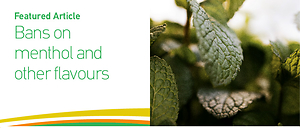In May 2020, the European Tobacco Products Directive (TPD), which bans characterizing flavors in cigarettes and roll-your-own tobacco (RYO) in the European Union (EU), extended its application to menthol1,2. Countries which were early adopters of flavor bans include Brazil, Canada, Ethiopia, the United Kingdom (UK), amongst others3. Two main regulatory approaches exist: a ban on characterizing flavors that allows for the presence of additives but not at detectable sensory levels (e.g. EU, UK), and a total ban on flavor additives that eliminates their presence altogether (e.g. Brazil, Canada). As more countries work towards adopting tobacco flavor bans, it is critical to understand how these policies are implemented, ascertain their population-level impact, and identify the regulatory challenges.
Initial evaluation of these bans has provided evidence for their positive impact as well as the challenges. Population-level data from the International Tobacco Control (ITC) Surveys in Canada and Europe have demonstrated that banning menthol and other flavors in cigarettes can lead to positive public health outcomes including increased quitting, without significant unintended consequences such as illicit purchasing4,5. The menthol cigarette ban in Canada led to 7.5% additional quitting among menthol smokers compared to non-menthol smokers4. Findings from the EUREST-PLUS ITC Europe Surveys, before and after the flavor ban, but prior to the menthol ban, found a reduction in menthol use5 as well as other flavors and improved health knowledge and beliefs among menthol smokers. However, a majority of menthol smokers in Canada switched to non-menthol cigarettes rather than quitting, and a substantial proportion of EU smokers continued to smoke menthol cigarettes prior to the ban and intended to either continue or switch to non-menthol cigarettes after the menthol ban, rather than quit4,5. This is not surprising, given the high addictiveness of cigarettes, coupled with the lack of promotion and availability of smoking cessation support, and the measures taken by the tobacco industry to circumvent and undermine menthol bans6.
In response to menthol bans, the industry has introduced menthol products that remain legal post-ban6, such as menthol cigarillos, menthol accessories sold separately (e.g. menthol-infused cards, filter capsules, and RYO papers and filters) and new cigarette blends with low levels of menthol6. This raises the question of whether a characterizing flavor ban, compared to a total additive ban, allows a gap where the industry-desirable properties of additives, such as the cooling effect of menthol, could operate at a subliminal level. Some EU Member States, such as Germany and Finland, have gone beyond the current TPD by prohibiting menthol as an additive at any level, based on the evidence that it facilitates inhalation7. Other questions remain: ‘To what extent can current methodologies for determining the presence of characterizing flavors (e.g. combination of sensory panels and chemical analysis8) withstand legal challenges?’, and ‘What is the feasibility of implementing each approach in more resource-constrained countries?’.
Early research supports the effectiveness of flavor bans in increasing quitting, while also highlighting the challenges. The following policy recommendations and areas for future research may maximize public health impact.
Major policy recommendations:
Include all tobacco products and accessories in flavor bans;
Accelerate implementation to stop sales of flavored tobacco quickly; and
Support menthol smokers in cessation efforts through smoking cessation programs and media campaigns.
Major areas of continued and future research:
Population-level impact of flavor bans, including smoking initiation, cessation, and tobacco-related morbidity and mortality, as well as possible unintended consequences such as illicit trade9;
Possible positive and negative consequences of a flavor ban on alternative nicotine products10,11; and
Comparative effectiveness of different regulatory approaches to ban flavors, e.g. ban on sensory perception of characterizing flavors versus total ban on flavor additives.


